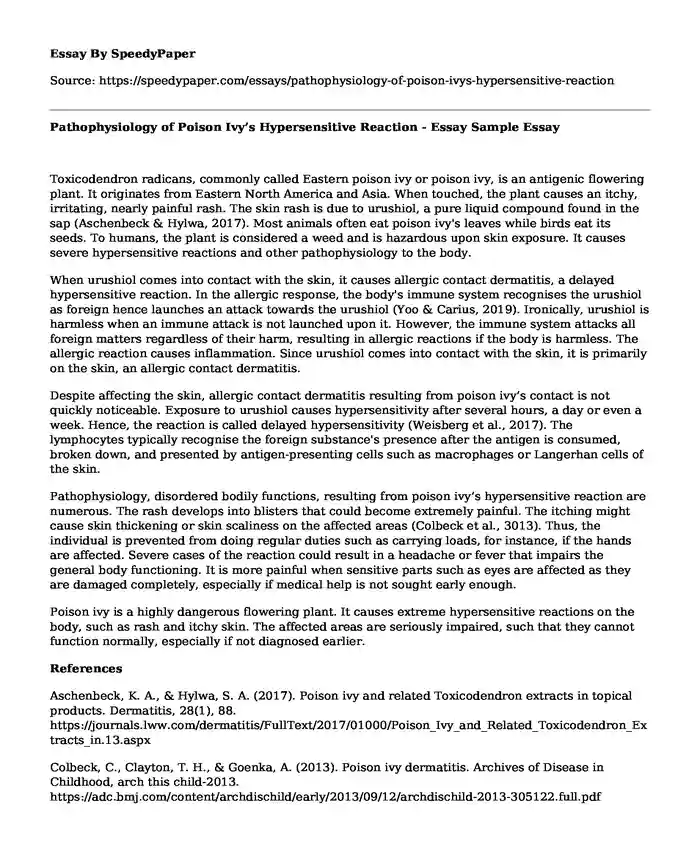Toxicodendron radicans, commonly called Eastern poison ivy or poison ivy, is an antigenic flowering plant. It originates from Eastern North America and Asia. When touched, the plant causes an itchy, irritating, nearly painful rash. The skin rash is due to urushiol, a pure liquid compound found in the sap (Aschenbeck & Hylwa, 2017). Most animals often eat poison ivy's leaves while birds eat its seeds. To humans, the plant is considered a weed and is hazardous upon skin exposure. It causes severe hypersensitive reactions and other pathophysiology to the body.
When urushiol comes into contact with the skin, it causes allergic contact dermatitis, a delayed hypersensitive reaction. In the allergic response, the body's immune system recognises the urushiol as foreign hence launches an attack towards the urushiol (Yoo & Carius, 2019). Ironically, urushiol is harmless when an immune attack is not launched upon it. However, the immune system attacks all foreign matters regardless of their harm, resulting in allergic reactions if the body is harmless. The allergic reaction causes inflammation. Since urushiol comes into contact with the skin, it is primarily on the skin, an allergic contact dermatitis.
Despite affecting the skin, allergic contact dermatitis resulting from poison ivy’s contact is not quickly noticeable. Exposure to urushiol causes hypersensitivity after several hours, a day or even a week. Hence, the reaction is called delayed hypersensitivity (Weisberg et al., 2017). The lymphocytes typically recognise the foreign substance's presence after the antigen is consumed, broken down, and presented by antigen-presenting cells such as macrophages or Langerhan cells of the skin.
Pathophysiology, disordered bodily functions, resulting from poison ivy’s hypersensitive reaction are numerous. The rash develops into blisters that could become extremely painful. The itching might cause skin thickening or skin scaliness on the affected areas (Colbeck et al., 3013). Thus, the individual is prevented from doing regular duties such as carrying loads, for instance, if the hands are affected. Severe cases of the reaction could result in a headache or fever that impairs the general body functioning. It is more painful when sensitive parts such as eyes are affected as they are damaged completely, especially if medical help is not sought early enough.
Poison ivy is a highly dangerous flowering plant. It causes extreme hypersensitive reactions on the body, such as rash and itchy skin. The affected areas are seriously impaired, such that they cannot function normally, especially if not diagnosed earlier.
References
Aschenbeck, K. A., & Hylwa, S. A. (2017). Poison ivy and related Toxicodendron extracts in topical products. Dermatitis, 28(1), 88. https://journals.lww.com/dermatitis/FullText/2017/01000/Poison_Ivy_and_Related_Toxicodendron_Extracts_in.13.aspx
Colbeck, C., Clayton, T. H., & Goenka, A. (2013). Poison ivy dermatitis. Archives of Disease in Childhood, arch this child-2013. https://adc.bmj.com/content/archdischild/early/2013/09/12/archdischild-2013-305122.full.pdf
Weisberg, A. J., Kim, G., Westwood, J. H., & Jelesko, J. G. (2017). Sequencing and de novo assembly of the Toxicodendron radicans (poison ivy) transcriptome. Genes, 8(11), 317. https://www.mdpi.com/2073-4425/8/11/317
Yoo, M. J., & Carius, B. M. (2019). Mango Dermatitis After Urushiol Sensitization. Clinical Practice and Cases in Emergency Medicine, 3(4), 361. https://www.ncbi.nlm.nih.gov/pmc/articles/PMC6861053/
Cite this page
Pathophysiology of Poison Ivy's Hypersensitive Reaction - Essay Sample. (2023, Dec 30). Retrieved from https://speedypaper.com/essays/pathophysiology-of-poison-ivys-hypersensitive-reaction
Request Removal
If you are the original author of this essay and no longer wish to have it published on the SpeedyPaper website, please click below to request its removal:
- Essay Example: Water Sprinklers for Cleaning PV Panels
- Architectural Engineering Essay Example
- Free Essay: The Security Dimensions of European Union Enlargement
- Free Essay on the Decline in the Honeybee Population in the U. S.
- Free Essay on the US/European Sanctions Against Russian Brought China and Russia Closer Together Economically
- Free Paper Sample on Description of Oxygen in Water
- Aphasia Research: Unraveling the Mysteries of Language and Brain Function - Paper Example
Popular categories





